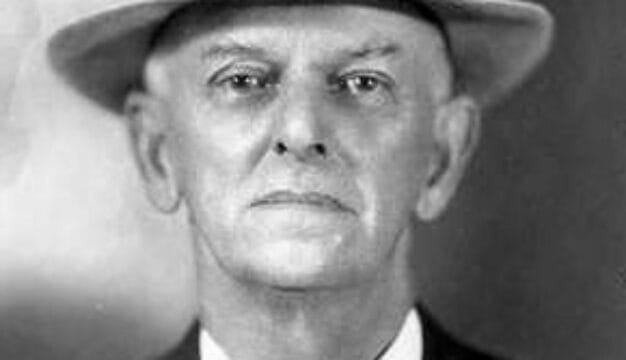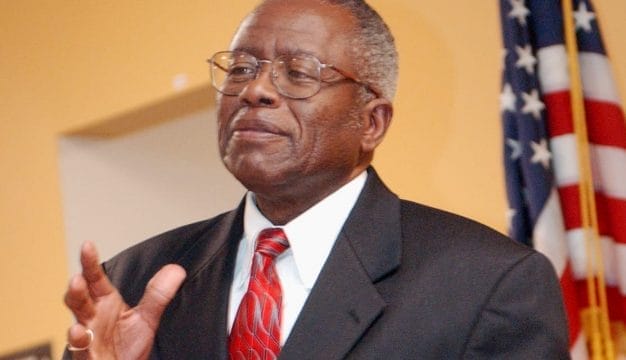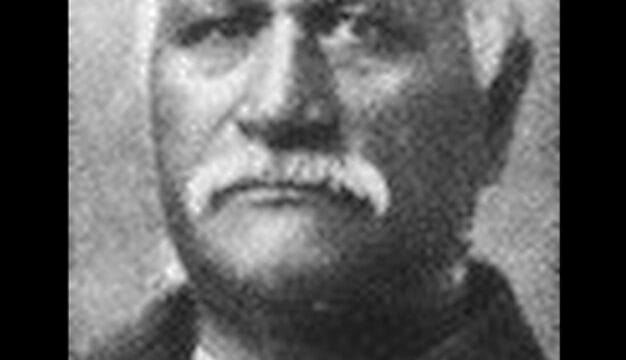Horseshoe Bend National Military Park
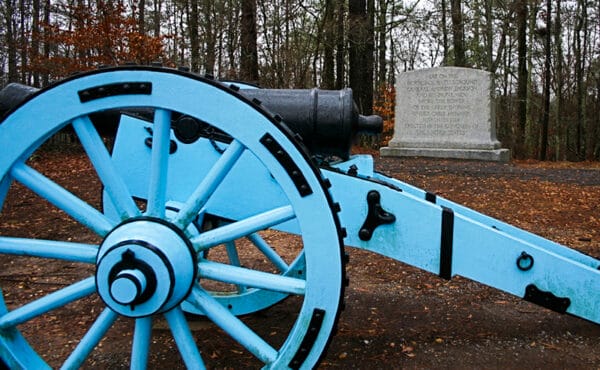 Horseshoe Bend National Military Park
Horseshoe Bend National Military Park was established to preserve the site of the Battle of Horseshoe Bend. This battle, named after a bend in the Tallapoosa River in northeast Tallapoosa County, was the final conflict in the Creek War of 1813-14 and marked the defeat of the Red Stick Creeks, led by Menawa, by Gen. Andrew Jackson and his forces. The 2,040-acre park was established by an act of Congress in 1956 and officially proclaimed on August 11, 1959 by Pres. Dwight D. Eisenhower.
Horseshoe Bend National Military Park
Horseshoe Bend National Military Park was established to preserve the site of the Battle of Horseshoe Bend. This battle, named after a bend in the Tallapoosa River in northeast Tallapoosa County, was the final conflict in the Creek War of 1813-14 and marked the defeat of the Red Stick Creeks, led by Menawa, by Gen. Andrew Jackson and his forces. The 2,040-acre park was established by an act of Congress in 1956 and officially proclaimed on August 11, 1959 by Pres. Dwight D. Eisenhower.
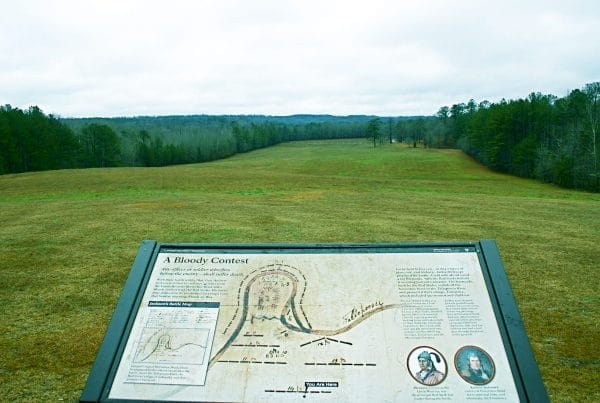 Battlefield at Horseshoe Bend
The roots of the park lie in a visit to the battlefield by Alabama Power Company executive Thomas Martin in 1923. At the time, the company was evaluating sites for potential dams and had purchased much of the land on which the battlefield sits some years earlier. Despite its appeal as a site for a dam, Martin recognized the historical significance of the battlefield and requested that the company abandon its plans for a dam downstream of the site. He also initiated the effort to designate the site a national park. He convinced the company to donate the property to the federal government and with Judge Clinton Jackson Coley helped organize the Horseshoe Bend Battle Park Association, serving as chair. Thomas D. Russell, president of Alabama-based clothing manufacturer Russell Corporation, served as president of the board. The board worked with Alabama congressman Albert Rains and senators Lister Hill and John Sparkman to draft legislation establishing the park. Rains then introduced the bill as HR 11766, and President Eisenhower signed it into law.
Battlefield at Horseshoe Bend
The roots of the park lie in a visit to the battlefield by Alabama Power Company executive Thomas Martin in 1923. At the time, the company was evaluating sites for potential dams and had purchased much of the land on which the battlefield sits some years earlier. Despite its appeal as a site for a dam, Martin recognized the historical significance of the battlefield and requested that the company abandon its plans for a dam downstream of the site. He also initiated the effort to designate the site a national park. He convinced the company to donate the property to the federal government and with Judge Clinton Jackson Coley helped organize the Horseshoe Bend Battle Park Association, serving as chair. Thomas D. Russell, president of Alabama-based clothing manufacturer Russell Corporation, served as president of the board. The board worked with Alabama congressman Albert Rains and senators Lister Hill and John Sparkman to draft legislation establishing the park. Rains then introduced the bill as HR 11766, and President Eisenhower signed it into law.
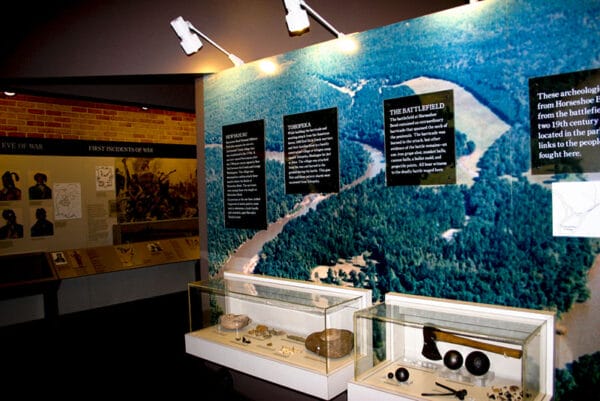 Visitor Center at Horseshoe Bend National Military Park
On March 27, 1964, Horseshoe Bend NMP officially opened to the public with the dedication of the park’s Visitor Center. In 1965, a three-mile touring road through the battlefield was constructed. Today, the Visitor Center features an auditorium that shows a 23-minute video about the park and its history. An updated museum explores the causes and consequences of the Creek War of 1813-14 and traces the history of the Muscogee (Creek) Nation in Alabama. Visitors to the park may view important sites on the battlefield by driving the auto tour road or walking a 2.8-mile nature trail. Each year, during the month of March, the park observes the anniversary of the battle with a living history event designed to focus attention on the participants of the battle. Creek, Cherokee and military camps are constructed on the field behind the park Visitor Center. In August, the park sponsors free symposium every August that features Alabama historians and park-connected themes that vary from year to year.
Visitor Center at Horseshoe Bend National Military Park
On March 27, 1964, Horseshoe Bend NMP officially opened to the public with the dedication of the park’s Visitor Center. In 1965, a three-mile touring road through the battlefield was constructed. Today, the Visitor Center features an auditorium that shows a 23-minute video about the park and its history. An updated museum explores the causes and consequences of the Creek War of 1813-14 and traces the history of the Muscogee (Creek) Nation in Alabama. Visitors to the park may view important sites on the battlefield by driving the auto tour road or walking a 2.8-mile nature trail. Each year, during the month of March, the park observes the anniversary of the battle with a living history event designed to focus attention on the participants of the battle. Creek, Cherokee and military camps are constructed on the field behind the park Visitor Center. In August, the park sponsors free symposium every August that features Alabama historians and park-connected themes that vary from year to year.
Horseshoe Bend National Military Park has 8 staff members who oversee visitor services, resource management, park administration and maintenance operations. The park receives nearly 70,000 visitors per year. Groups visiting Horseshoe Bend may schedule battlefield tours, musket demonstrations, and other activities by contacting park staff. Except for federal holidays, the park is open 8:00 a.m. to 5:00 p.m. and the visitor center is open from 9:00 a.m. to 4:30 p.m. daily. There is no admission fee.

